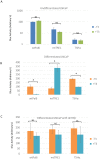Reversing thyroid-hormone-mediated repression of a HSV-1 promoter via computationally guided mutagenesis
- PMID: 28916515
- PMCID: PMC5702054
- DOI: 10.1242/jcs.204222
Reversing thyroid-hormone-mediated repression of a HSV-1 promoter via computationally guided mutagenesis
Abstract
Thyroid hormones (THs) and their DNA-binding nuclear receptors (TRs) direct transcriptional regulation in diverse ways depending on the host cell environment and specific promoter characteristics of TH-sensitive genes. This study sought to elucidate the impact on transcriptional repression of nucleotide sequence or orientation within TR binding sites - the TH response elements (TREs) of TH-sensitive promoters - to better understand ligand-dependent transcriptional repression of wild-type promoters. Computational analysis of the HSV-1 thymidine kinase (TK) gene TRE bound by TR and retinoid X receptor (RXR) revealed a single TRE point mutation sufficient to reverse the TRE orientation. In vitro experiments showed that the TRE point mutation had distinct impacts on promoter activity, sufficient to reverse the TH-dependent negative regulation in neuroendocrine differentiated cells. This point mutation altered the promoter's regulatory mechanism by discrete changes in transcription factor TR occupancy and altered enrichment of the repressive chromatin modification of histone-3-lysine-9-trimethyl (H3K9Me3). Insights relating to this negative TRE (nTRE) mechanism aids our understanding of other nTREs and TRE mutations associated with TH and herpes diseases.
Keywords: Differentiation; Herpesvirus; Histone modification; Thyroid hormone; Transcription factor.
© 2017. Published by The Company of Biologists Ltd.
Conflict of interest statement
Competing interestsThe authors declare no competing or financial interests.
Figures





Similar articles
-
Regulation of herpes simplex virus type 1 thymidine kinase gene expression by thyroid hormone receptor in cultured neuronal cells.J Neurovirol. 2010 Feb;16(1):13-24. doi: 10.3109/13550280903552412. J Neurovirol. 2010. PMID: 20113192 Free PMC article.
-
The human thyrotropin-releasing hormone gene is regulated by thyroid hormone through two distinct classes of negative thyroid hormone response elements.Mol Endocrinol. 1995 May;9(5):540-50. doi: 10.1210/mend.9.5.7565802. Mol Endocrinol. 1995. PMID: 7565802
-
DNA binding and interaction with the nuclear receptor corepressor of thyroid hormone receptor are required for ligand-independent stimulation of the mouse preprothyrotropin-releasing hormone gene.Mol Cell Endocrinol. 1999 Aug 20;154(1-2):137-49. doi: 10.1016/s0303-7207(99)00032-5. Mol Cell Endocrinol. 1999. PMID: 10509808
-
[Molecular mechanism of thyroid hormone action].Arq Bras Endocrinol Metabol. 2004 Feb;48(1):25-39. doi: 10.1590/s0004-27302004000100005. Epub 2004 Jun 1. Arq Bras Endocrinol Metabol. 2004. PMID: 15611816 Review. Portuguese.
-
Molecular Functions of Thyroid Hormone Signaling in Regulation of Cancer Progression and Anti-Apoptosis.Int J Mol Sci. 2019 Oct 9;20(20):4986. doi: 10.3390/ijms20204986. Int J Mol Sci. 2019. PMID: 31600974 Free PMC article. Review.
References
-
- Carr F. E., Kaseem L. L. and Wong N. C. (1992). Thyroid hormone inhibits thyrotropin gene expression via a position-independent negative L-triiodothyronine-responsive element. J. Biol. Chem. 267, 18689-18694. - PubMed
MeSH terms
Substances
Grants and funding
LinkOut - more resources
Full Text Sources
Other Literature Sources

